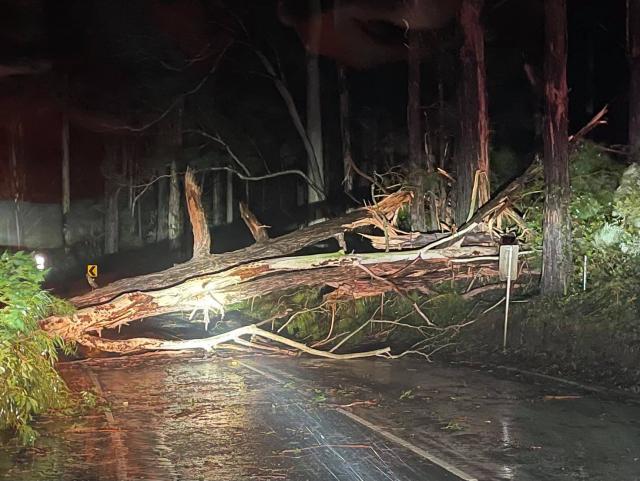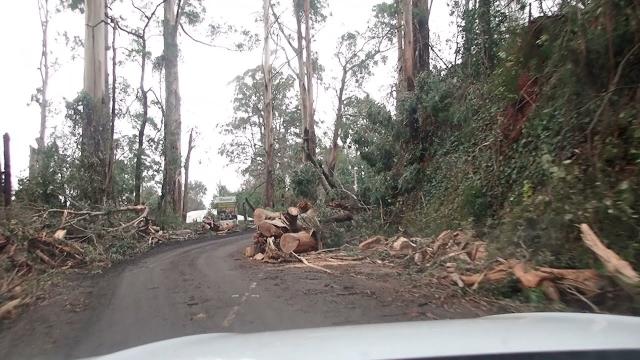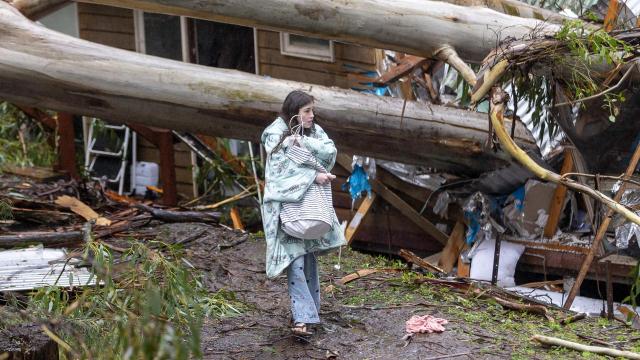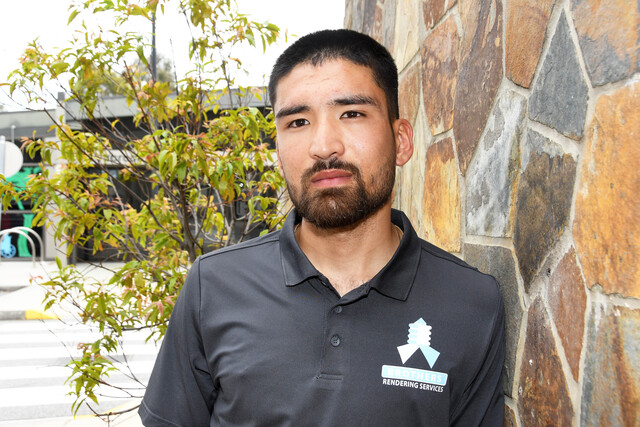On the evening of Wednesday 9 June 2021, Emerald SES Unit Controller Ben Owen remembers the weather conditions being “worse than ever”.
“You probably really didn’t get a grasp of what was going on around you because it was dark and black and you saw the headlights in the vehicle where you were driving, but you didn’t see the whole pitch until daybreak,” Mr Owen said.
“But you could certainly hear in the darkness of the night with the wind howling, that the branch is breaking and the trees falling either close or in a distance… not knowing your fate.”
Lilydale SES Unit Controller Shaun Caulfield expected that day to be windy, but did not believe it would reach the recorded 128-kilometre gush it became.
“We first had a call for someone who was trapped in their house due to rising floodwaters, at six o’clock, we had a swift water rescue event for someone who had driven a car through a cross a flooded road and then around that 8.30 and 9 o’clock mark, it really started to escalate and we started getting more and more calls up in the Mt Dandenong, Kalorama and Olinda,” Mr Caulfield said.
“In Olinda, the weather station went off the air around 8.30pm, so we actually don’t know if there were any stronger winds after that because they had lost power and internet connection.
“The pager was just continuously going off. It would go off for one job and you’d silence and instantly go up again with another job.”
The ferocious winds on that night two years ago saw at least 25,000 trees fall and 200 properties damaged; 81 of which were left uninhabitable.
The fallen trees blocked roads and bought down telephone and power lines, leaving thousands without heating and phone or internet connection for weeks.
Mr Owen said it was a “miracle” no residents or emergency service personnel died during the storm event.
“When you think back, the number of houses that were destroyed, number of houses that were non-livable after that, that has the flow on to how long people need to take to rebuild and rehome
themselves,” Mr Owen said.
In the 24 months since the event, insurance has proven a difficult hurdle for residents, with some landowners receiving planning permits, but none having yet rebuilt their homes.
According to the Insurance Council of Australia (ICA), there are $312.46 million in incurred costs from the disaster.
There were 34 thousand claims submitted to insurers, with a closed rate of 94 per cent.
There are still 1,908 outstanding claims, with an average claim cost of $9,087.
“It is a known fact that it takes more than 12 months to rebuild and yet this, for most, is the amount of time given from insurance companies for rental assistance,” Yarra Ranges Mayor Cr Jim Child said.
“It’s so important people understand that when there is a disaster like the 2021 June Storm, rebuilding takes years and not months,” Cr Child said.
“You need to think what would happen to you if you lost your home as a result of a disaster – what insurance cover would you have and how would you be able to manage this process.”
There have been 65 approvals for repairs to dwellings including decks, verandas, outbuildings, garages, carports, retaining walls and fences.
“While some residents had chosen to sell rather than rebuild, others had been unable to afford to rebuild to meet current standards which is required from a Building Permit point of view and future insurance,” Child said.
“Residents have informed us that their insurers have stated that they can only rebuild like for like which will not meet current building standards.
“Once again Yarra Ranges Council is calling on insurance companies to do the right thing – support our residents with their rebuilding journey and continue to provide rental assistance and allow people to build to current standards and not like for like.”
Mr Caulfied and Lilydale SES’s deputy controller Louise Andrews said they remember hearing the people in Kalorama had no power, deciding they needed to do something to help the community.
“We’d heard they’d started cooking up at the oval, so we used our Facebook page and put out a call that they’d pick up donated goods and supplies from Montrose and take them up to the Kalorama Oval,” Ms Andrews said.
Mr Owen said 24 months after the June storm, people are thinking about disaster preparedness for events including storms and fire.
“The key thing is for people to be vigilant and alert,” he said.
“But the typical message is, if power lines are involved, avoid those. If you’re going to use the generator, do so safely and know that they’re not under your building… they could cause a fire risk.”
To reflect upon the June 2021 storm event, a drop-in session is being held at Karwarra Gardens on Friday 9 June for the community to get together to have a quiet chat and listen to some peaceful music while enjoying a cup of tea and some soup.
Residents who have experienced trauma, damage or loss as a result of the June storm are also able to discuss their circumstances with the counselling support service Windermere by contacting 0408 521 320.
Cr Child said staff from Council’s Emergency Management Team also continued to work closely with the community, offering a variety of events, advice or connection to a range of support services.
“In addition to continuing to support residents impacted by the storm, we have a wide range of resilience programs that are being undertaken as part of the Federal Government’s Preparing Australian Communities fund.
“Responding in an emergency is as much about preparation and planning as it is about the actual response and clean-up itself.”











